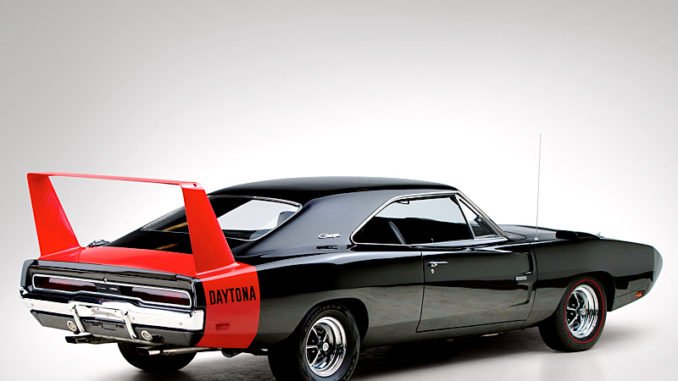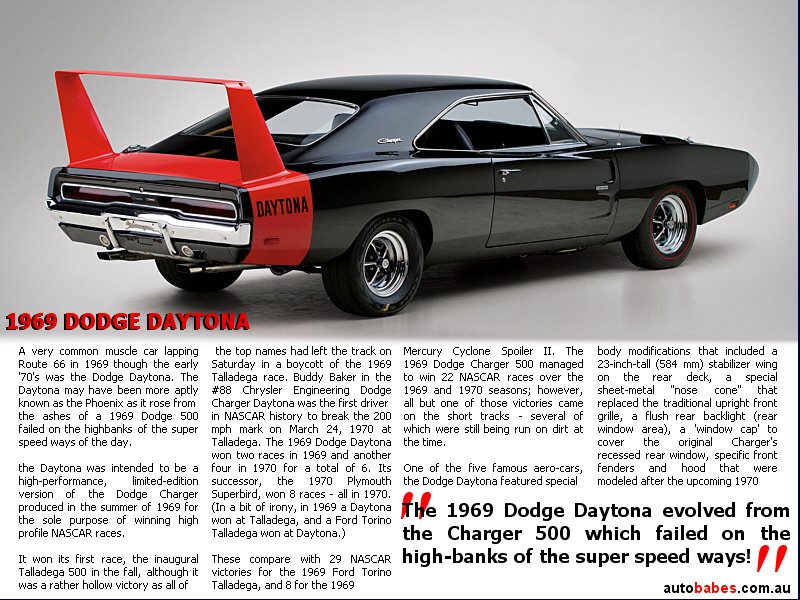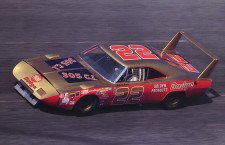
1969 Dodge Daytona
A very common muscle car lapping Route 66 in 1969 though the early ’70’s was the Dodge Daytona. The Daytona may have been more aptly known as the Phoenix as it rose from the ashes of a 1969 Dodge 500 failed on the highbanks of the super speed ways of the day.
the Daytona was intended to be a high-performance, limited-edition version of the Dodge Charger produced in the summer of 1969 for the sole purpose of winning high profile NASCAR races.
It won its first race, the inaugural Talladega 500 in the fall, although it was a rather hollow victory as all of the top names had left the track on Saturday in a boycott of the 1969 Talladega race. Buddy Baker in the #88 Chrysler Engineering Dodge Charger Daytona was the first driver in NASCAR history to break the 200 mph mark on March 24, 1970 at Talladega. The 1969 Dodge Daytona won two races in 1969 and another four in 1970 for a total of 6. Its successor, the 1970 Plymouth Superbird, won 8 races – all in 1970. (In a bit of irony, in 1969 a Daytona won at Talladega, and a Ford Torino Talladega won at Daytona.)
These compare with 29 NASCAR victories for the 1969 Ford Torino Talladega, and 8 for the 1969 Mercury Cyclone Spoiler II. The 1969 Dodge Charger 500 managed to win 22 NASCAR races over the 1969 and 1970 seasons; however, all but one of those victories came on the short tracks – several of which were still being run on dirt at the time.
One of the five famous aero-cars, the Dodge Daytona featured special body modifications that included a 23-inch-tall (584 mm) stabilizer wing on the rear deck, a special sheet-metal “nose cone” that replaced the traditional upright front grille, a flush rear backlight (rear window area), a ‘window cap’ to cover the original Charger’s recessed rear window, specific front fenders and hood that were modeled after the upcoming 1970 Charger, stainless steel A-pillar covers and fender mounted tire clearance/brake cooling scoops.
The Daytona was built on the 1969 Charger’s 500 trim specifications, meaning that it carried a heavy-duty suspension and brake setup and was equipped with a 440 CID Magnum engine as standard.
Of special note to collectors is the optional 426 CID Hemi V8 engine, which only 70 of the 503 Daytonas carried. It had a corporate cousin in the “one year-only” 1970 Plymouth Superbird.
The “Winged Warriors”, as they were affectionately known, did not compete for long in NASCAR’s top Cup series. Because of their exceptional speed and performance, NASCAR subsequently changed the rule book, effectively banning all five of the Aero Cars from Dodge, Ford, Mercury, and Plymouth from competition by the end of 1970.
The Dodge Daytona is now a very rare and valuable collectible, with 440-powered Daytonas reaching into six-figure territory and 426 hemi-engined cars passing the $300,000 mark.
The “Super Charger IV EL”, which looked like a roadster prototype spin-off of the Charger Daytona minus the roof and spoiler, is seen as a pimp-mobile in the 1974 film Truck Turner. Actually, it was just an older Charger show car updated with a SuperBird nose. In addition to the internal combustion engine, the powertrain concept for the first time, features the integration of two hybrid systems. As in the past, a Motor-Generator-Unit (MGU) during braking, recovers kinetic energy at the front axle which flows into a flywheel energy storage system. For the first time, the turbocharger of the internal combustion engine is linked to an electrical machine which makes it possible to convert the thermal energy of the exhaust gas flow into electric energy – for instance when the boost pressure limit has been reached. This energy also flows into the flywheel energy storage system. When the car accelerates, the stored energy can either flow back to the MGU at the front axle or to the innovative electric turbocharger, depending on the operating strategy.
The overall design of these systems and their direct impact on engine and powertrain management require highly complex coordination and tuning work. Audi Sport initially performed theoretical analyses and simulations followed by rig testing and, since October, by track tests. The options available to the drivers and engineers as a result of the new technology are now more extensive than ever before.
New freedoms, accompanied by greater restrictions – this is how the new framework conditions for aerodynamics can be put in a nutshell. Some examples: The 10 centimeter narrower body of the new LMP1 sports car means that the front of the R18 becomes mathematically smaller – which is an advantage. The bodywork accommodates slimmer wheels, which, in turn, reduces aerodynamic drag. This is contrasted by other innovations that do not provide any advantages in aerodynamics. At 1,050 millimeters, the race car has to be 20 millimeters higher than before and larger cockpit dimensions are prescribed as well. This leads to less favorable aerodynamics. The lower overall width of the car results in a slimmer underfloor. In addition, it features a completely different shape in the area of the cutouts for the front wheels. Consequently, the area that can produce downforce becomes smaller.
With respect to designing the front end, the engineers enjoy new freedoms. Instead of a diffusor, a genuine front wing with a flap may be used for the first time. This promises aerodynamic advantages and lower costs, as this part of the bodywork will lend itself to easier modification to suit the various race tracks. In the past, it was necessary to produce different bodywork assemblies.
On the other hand, greater limits have been imposed on the aerodynamic design freedoms at the rear end. Use of the exhaust gas in the area of the rear diffusor, as in the case of the 2013-generation Audi R18 e-tron quattro, is now prohibited.








Be the first to comment